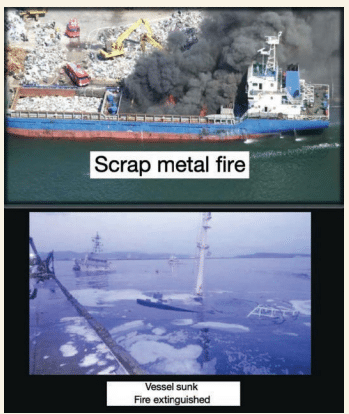Real Life Incident: Scrap Metal Fire Extinguished But Vessel Sunk
A general cargo vessel was loading scrap metal into both the forward and aft cargo holds. A loader was lowered into the aft cargo hold to smooth the heap of scrap metal in certain areas. At one point, the operator of the loader saw a small amount of white smoke rising from within the scrap heap in the port aft section of the hold. He immediately raised the alarm.
As edited from JTSB (Japan) report MA2018-10
The shore fire department was called while crew prepared fire hoses. Soon, the loader operator – who was still in the hold – saw flames in the scrap heap. A few minutes later, crew were able to direct water jets from fire hoses onto the scrap metal heap. The loader operator evacuated the hold, leaving the arm of the loader extended above the hatch coaming. Local shore fire fighters arrived and took control of the fire fighting activities. Not long after, the crew were asked to evacuate the vessel for their safety.

The shore fire fighters decided, based on experience in past firefighting of ship fires, to use a protein foam spray delivered from a large aerial-platform chemical-spray fire truck. As they made preparations for the application of the protein foam spray, the vessel listed to port, and the firefighters on the vessel withdrew. The fire continued to increase in size.
About an hour after arriving, the shore fire fighters began spraying the protein foam into the aft cargo hold. This technique did not seem to have the desired effect and the shore firefighters asked the Master for permission to continue to use water. Permission was granted, but some 12 hours later, after the application of copious amounts of water, the vessel sank alongside the berth. The fire was then declared extinguished.
The investigation found, among other things, that the source of the fire was most likely to be a spark created by contact between metal objects, a battery, etc., in the scrap. The source then ignited combustible material mixed in the scrap (eg plastic, rubber, wood chips, paper).
It was not possible to determine the exact origin of the fire. The investigation also found that the Master did not think to use the hold’s fixed CO2 firefighting equipment after the fire was first discovered. In fact, this was a moot point because the loader was left with its arm extended above the hatch coaming. This would have prevented the closing of the hold’s hatch, a necessary first step before releasing CO2.
Lessons learned
- As seen in the previous MARS report (202345), scrap metal, while intuitively innocuous and listed as noncombustible in the IMSBC Code, is nonetheless a fire risk.
- Reactions during an emergency are honed with training. Masters and crew should be aware of the most efficient fire fighting methods on their ship and quickly be able to put these into practice.
- Copious and uncontrolled amounts of water poured into a ship will cause a loss of stability and possibly the foundering of the vessel. This will, however, probably succeed in extinguishing any fire on board.
Source: The Nautical Institute
Do you have info to share with us ? Suggest a correction
About Author
Marine Insight News Network is a premier source for up-to-date, comprehensive, and insightful coverage of the maritime industry. Dedicated to offering the latest news, trends, and analyses in shipping, marine technology, regulations, and global maritime affairs, Marine Insight News Network prides itself on delivering accurate, engaging, and relevant information.

About Author
Marine Insight News Network is a premier source for up-to-date, comprehensive, and insightful coverage of the maritime industry. Dedicated to offering the latest news, trends, and analyses in shipping, marine technology, regulations, and global maritime affairs, Marine Insight News Network prides itself on delivering accurate, engaging, and relevant information.
- Real Life Incidents: Near Miss In Open Water And Good Visibility
- Real Life Incident: Poor Situational Awareness Leads to Collision
- Real Life Incident: Monkey’s Fist Knocks on Office Window
- Real Life Incident: Paint Storage Slip-Up On Ship
- Real Life Incident: Checklist Mentality Is A Burning Problem
- Real Life Incident: Vessel Speed Exacerbates Bank Suction
Latest Case studies Articles You Would Like:
Subscribe To Our Newsletters
By subscribing, you agree to our Privacy Policy and may receive occasional deal communications; you can unsubscribe anytime.















